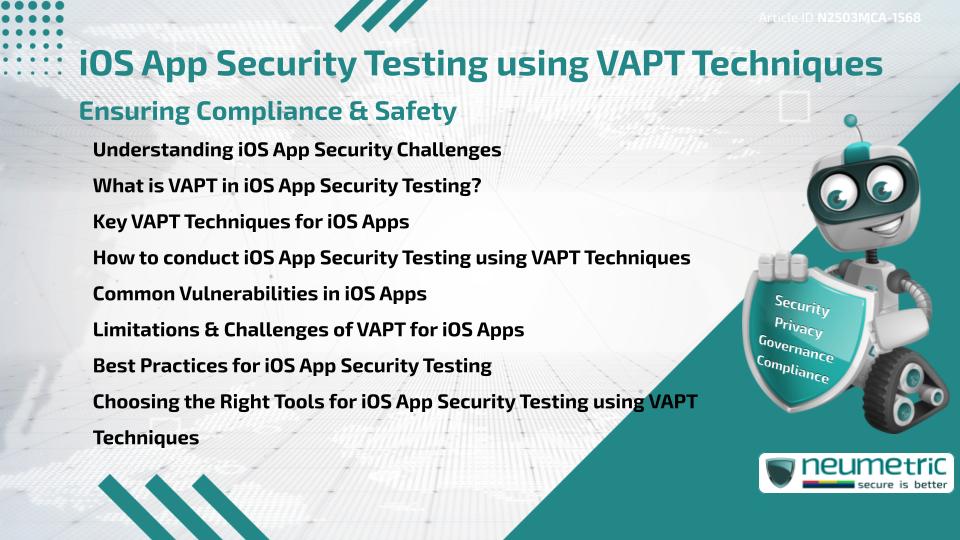Table of Contents
ToggleIntroduction
iOS Applications play a crucial role in Enterprise Mobility, Handling Sensitive Data & ensuring seamless User Experiences. However, these Apps are often targeted by Cyber Threats, making Security a Top Priority. iOS App security Testing using VAPT Techniques helps identify Vulnerabilities & mitigate Risks effectively. This article explores VAPT Techniques, Challenges & Best Practices for securing iOS Applications.
Understanding iOS App Security Challenges
iOS Applications benefit from Apple’s robust Security Architecture, but they are not immune to Threats. Common Security Concerns include:
- Insecure Data Storage: Poor Encryption Practices can expose Sensitive User data.
- Weak Authentication Mechanisms: Apps with weak Login Protection are prone to Brute Force attacks.
- Improper API Security: Weak API Authentication & Authorization can lead to Data Breaches.
- Reverse Engineering Threats: Attackers can decompile iOS Apps to uncover Vulnerabilities.
- Malicious Code Injection: Weak Input Validation can lead to Code Execution Vulnerabilities.
What is VAPT in iOS App Security Testing?
Vulnerability Assessment & Penetration Testing [VAPT] is a Security Evaluation Process that combines two (2) key Approaches:
- Vulnerability Assessment: Automated Scanning to detect Security Flaws.
- Penetration Testing: Simulated Attacks to evaluate real-world Risks.
VAPT helps Security Teams proactively identify & fix Weaknesses before Attackers exploit them.
Key VAPT Techniques for iOS Apps
Effective iOS App Security Testing using VAPT Techniques involves various methodologies, including:
- Static Application Security Testing [SAST]: Analyzing Source Code for Vulnerabilities without executing the App.
- Dynamic Application Security Testing [DAST]: Assessing the App during Runtime to detect real-world Exploits.
- Network Security Testing: Examining API Communications, Encryption & Authentication mechanisms.
- Reverse Engineering Analysis: Evaluating how attackers can Decompile & Manipulate App Binaries.
- Runtime Application Self-Protection [RASP]: Implementing Security Controls within the App to detect & respond to Threats.
How to conduct iOS App Security Testing using VAPT Techniques
- Define Scope: Identify Security Objectives, Test Environments & Compliance Requirements.
- Perform Static Analysis: Scan Source Code for common Vulnerabilities using Automated Tools.
- Conduct Dynamic Testing: Simulate attacks & monitor App behavior under real-world conditions.
- Analyze Network Traffic: Inspect API Communications & Encryption Protocols.
- Test Authentication & Authorization: Ensure robust Login Mechanisms & Role-Based Access Control [RBAC].
- Perform Penetration Testing: Manually exploit Vulnerabilities to assess Risk Levels.
- Generate Reports & Remediate: Document Findings, prioritise Fixes & enhance Security Measures.
Common Vulnerabilities in iOS Apps
Some frequently identified Security Issues during iOS App Security Testing using VAPT Techniques include:
- Insecure Data Storage (example: Unencrypted Sensitive Information in plist Files)
- Poor API Security (example: lack of proper Authentication & Authorization)
- Code Injection Vulnerabilities (example: SQL Injection or Command Injection)
- Weak Encryption practices (example: outdated Cryptographic Algorithms)
- Lack of Jailbreak Detection Mechanisms
Limitations & Challenges of VAPT for iOS Apps
While VAPT is effective, it has certain limitations:
- Limited access to Source Code: Not all Security Tests can be conducted without access to Source Code.
- iOS Sandboxing restrictions: Apple’s strict Security Policies limit certain Testing Methodologies.
- Time & Resource-intensive: Penetration Testing requires Skilled Professionals & significant time investment.
Best Practices for iOS App Security Testing
- Use a combination of Automated & Manual Testing Techniques.
- Implement Secure Coding Practices to prevent Vulnerabilities.
- Ensure Secure API Communication with proper Authentication.
- Regularly update Libraries & Dependencies to mitigate Risks.
- Integrate Security Testing into the App Development Lifecycle.
Choosing the right Tools for iOS App Security Testing using VAPT Techniques
Selecting the right Tools enhances the effectiveness of VAPT. Some widely used Tools include:
- Burp Suite: For intercepting & analyzing Network Traffic
- Mobile Security Framework [MobSF]: For Automated Security Analysis
- Frida & Objection: For Runtime Security Testing
Takeaways
iOS App Security Testing using VAPT Techniques is essential for identifying Vulnerabilities & safeguarding Sensitive Data. By implementing comprehensive Security Testing strategies, businesses can enhance App resilience against Cyber Threats.
FAQ
What is the importance of iOS App security testing using VAPT techniques?
VAPT ensures that iOS Applications are free from Vulnerabilities by identifying Security Flaws & mitigating Risks.
How often should iOS Apps undergo security testing using VAPT techniques?
It is recommended to conduct VAPT during Development, before Release & periodically to address emerging Threats.
What are the common tools used for iOS App security testing using VAPT techniques?
Popular tools include Burp Suite, MobSF, Frida, Objection & OWASP ZAP for various Security Assessments.
Can VAPT detect all Vulnerabilities in an iOS App?
While VAPT identifies most security flaws, no method guarantees 100% Vulnerability detection. Combining manual & automated testing improves results.
Does Apple provide built-in security for iOS Apps?
Yes, Apple enforces strict Security Measures, but Developers must implement additional security layers to protect against advanced Threats.
How does Penetration Testing differ from Vulnerability Assessment in iOS Apps?
Vulnerability Assessment identifies security flaws, while Penetration Testing exploits Vulnerabilities to assess their impact.
What are the challenges of conducting VAPT on iOS Apps?
Challenges include limited access to Source Code, iOS Sandboxing restrictions & the need for skilled Security Professionals.
How can developers secure iOS Apps against reverse engineering?
Using Code Obfuscation, Anti-Debugging Techniques & Encryption can help prevent reverse engineering Threats.
What Compliance standards require iOS App security testing using VAPT techniques?
Standards like ISO 27001, SOC 2, GDPR & HIPAA mandate security testing to protect Sensitive Data & ensure Compliance.
Need help?
Neumetric provides organisations the necessary help to achieve their Cybersecurity, Compliance, Governance, Privacy, Certifications & Pentesting goals.
Organisations & Businesses, specifically those which provide SaaS & AI Solutions, usually need a Cybersecurity Partner for meeting & maintaining the ongoing Security & Privacy needs & requirements of their Clients & Customers.
SOC 2, ISO 27001, ISO 42001, NIST, HIPAA, HECVAT, EU GDPR are some of the Frameworks that are served by Fusion – a centralised, automated, AI-enabled SaaS Solution created & managed by Neumetric.
Reach out to us!





